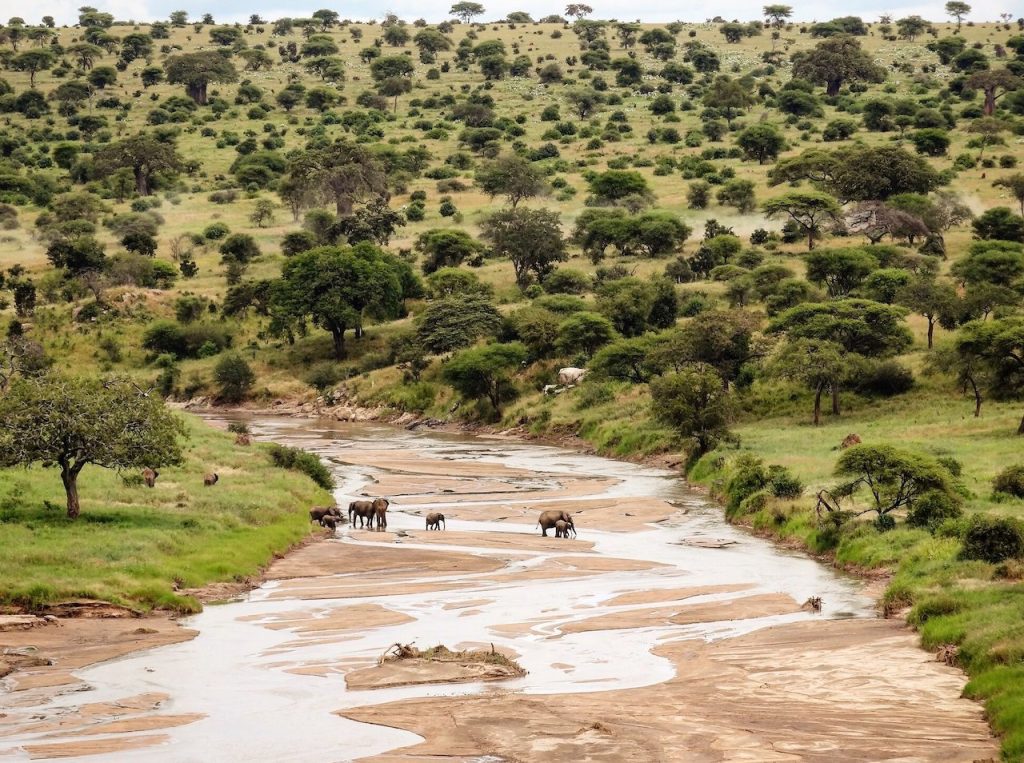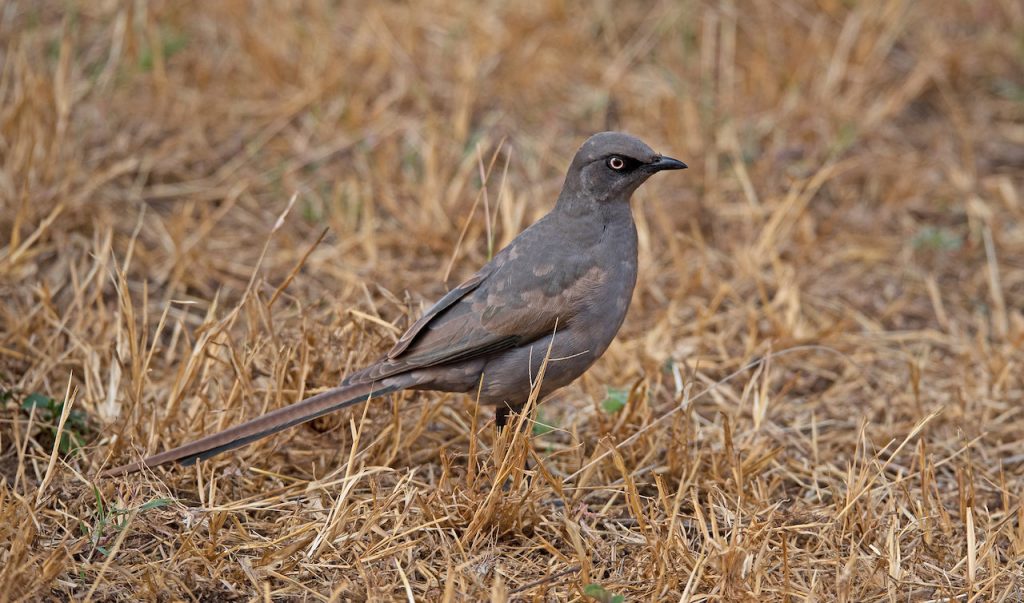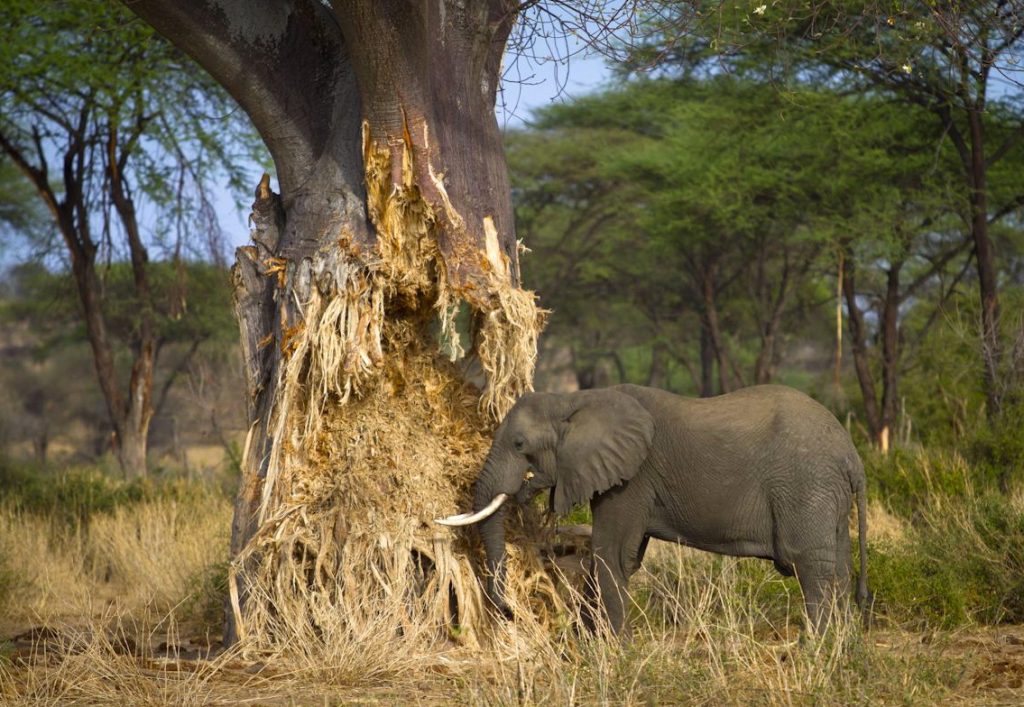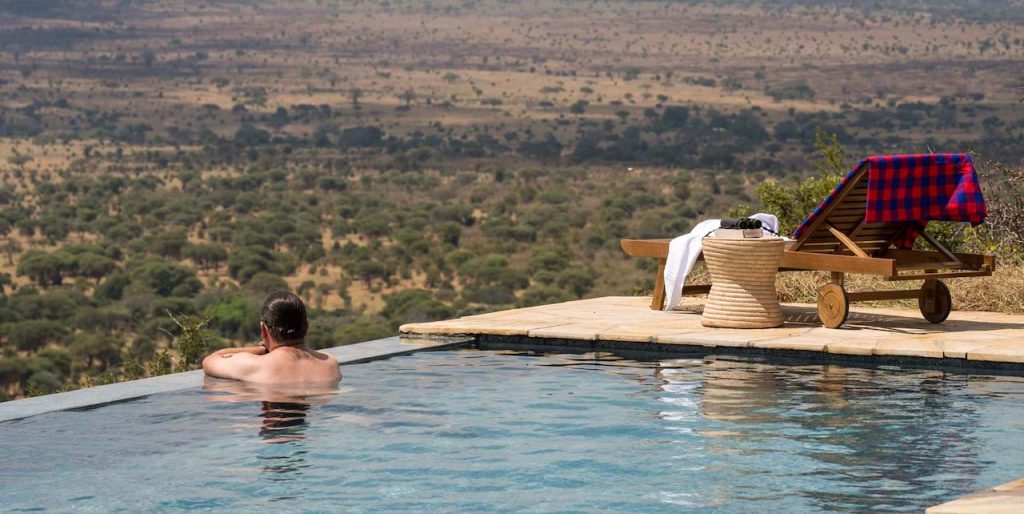Nestled within the heart of Tanzania, Tarangire National Park stands as a testament to the country’s commitment to preserving its natural heritage. Established in 1970, this expansive park covers approximately 2,850 square kilometers, making it one of the most biodiverse and captivating destinations in East Africa. Its unique ecosystems, iconic baobab trees, and thriving wildlife population make Tarangire a haven for nature enthusiasts and safari adventurers.
Geography and Formation
Tarangire National Park, situated in the northern part of Tanzania, is characterized by diverse landscapes that transition seamlessly from open grassy plains to acacia woodlands. The park’s defining feature is the meandering Tarangire River, which serves as a lifeline for its inhabitants. The park’s formation, shaped over millions of years, showcases the geological forces that have sculpted the East African terrain.
Wildlife Extravaganza in the Tarangire National Park
 Known as the “Elephant Playground,” Tarangire is renowned for its massive elephant herds that freely roam the park. Beyond elephants, Tarangire boasts a remarkable variety of wildlife, including lions, giraffes, wildebeests, zebras, and an abundance of bird species. The park’s diverse habitats, ranging from grassy savannas to dense woodlands, create an ideal environment for a thriving and dynamic ecosystem.
Known as the “Elephant Playground,” Tarangire is renowned for its massive elephant herds that freely roam the park. Beyond elephants, Tarangire boasts a remarkable variety of wildlife, including lions, giraffes, wildebeests, zebras, and an abundance of bird species. The park’s diverse habitats, ranging from grassy savannas to dense woodlands, create an ideal environment for a thriving and dynamic ecosystem.
Commonly spotted animals in Tarangire
Elephants:
Tarangire is renowned as the “Elephant Playground” due to the large herds that roam freely. These majestic creatures, often seen against the backdrop of baobab-dotted landscapes, contribute to the park’s unique charm.
Lions:
As apex predators, lions inhabit the savannas and woodlands of Tarangire. The park’s diverse habitats provide ideal conditions for these predators to establish territories and engage in their intricate social structures.
Giraffes:
Graceful giraffes, with their elegant necks towering above acacia trees, are a common sight in Tarangire. The open grasslands provide an ideal habitat for these gentle giants to move gracefully.
Wildebeests:
Joining the ranks of grazers in Tarangire, wildebeests contribute to the dynamic ecosystem. Their movements across the plains, often in the company of zebras, create a captivating spectacle.
Zebras:
Striped herds of zebras add contrasting beauty to the landscape of Tarangire. These social animals are frequently seen grazing and interacting in the open grassy areas.
Buffalos:
Herds of buffalos graze on the open plains, creating a powerful and iconic image of the African wilderness. Their presence adds to the richness of the park’s wildlife population.
Leopards:
Though elusive, leopards inhabit the woodlands and riverine areas of Tarangire. Lucky visitors may catch a glimpse of these solitary and stealthy predators during a safari.
Cheetahs:
Tarangire provides suitable hunting grounds for cheetahs, the fastest land animals. Their sleek and slender figures are well adapted to the park’s grassy expanses.
Hyenas:
Scavengers and skilled hunters, hyenas are part of the park’s predator guild. Their distinctive calls often echo through the night, adding to the soundscape of Tarangire.
Elands:
The largest antelope species, elands, can be spotted in Tarangire, contributing to the park’s biodiversity. These herbivores add to the tapestry of grazers in the region.
Ostriches:
The open landscapes of Tarangire are home to ostriches, the world’s largest and heaviest birds. Their distinctive appearance and impressive speed make them a unique addition to the park’s fauna.
Warthogs:
Inhabitants of grassy plains and open woodlands, warthogs can be seen foraging in Tarangire. Their distinctive appearance, with facial warts and upward-curving tusks, makes them easily recognizable.
Mongoose:
The park is home to various mongoose species, agile and curious creatures that navigate the grasslands in search of insects and small prey.
Baboons and Monkeys:
Tarangire hosts populations of olive baboons and vervet monkeys. These social primates are often seen in troops, adding a lively element to the park’s wildlife.
Nile Crocodiles:
Found near water bodies, including the Tarangire River, Nile crocodiles are skilled predators. They bask on riverbanks and are often observed gliding through the water.
African Pythons:
In the woodlands and thickets, African pythons can be encountered. These non-venomous snakes are part of the diverse reptile population in Tarangire.
Pangolins:
Elusive and nocturnal, pangolins inhabit the park’s landscapes. These unique creatures with scales are part of Tarangire’s lesser-seen wildlife.
Pangolins:
Elusive and nocturnal, pangolins inhabit the park’s landscapes. These unique creatures with scales are part of Tarangire’s lesser-seen wildlife.
Tarangire National Park offers an immersive safari experience, where each encounters with these remarkable animals adds a chapter to the ongoing narrative of preservation and appreciation for the wild. Whether witnessing elephants at a watering hole or observing the intricate behaviors of lions, a journey into Tarangire is a symphony of nature’s bounty—an exploration of a truly remarkable corner of East Africa’s wilderness.
Common Birds in Tarangire National Park
 Tarangire National Park isn’t just a sanctuary for charismatic mammals; it’s also a haven for birdwatchers, boasting over 550 bird species. The park’s varied landscapes, from grassy plains to riverine forests, create diverse habitats that attract a stunning array of avian species. Here’s a glimpse into the vibrant birdlife that graces the skies and trees of Tarangire:
Tarangire National Park isn’t just a sanctuary for charismatic mammals; it’s also a haven for birdwatchers, boasting over 550 bird species. The park’s varied landscapes, from grassy plains to riverine forests, create diverse habitats that attract a stunning array of avian species. Here’s a glimpse into the vibrant birdlife that graces the skies and trees of Tarangire:
Raptors:
African Fish Eagle: A majestic sight near water bodies, this raptor with distinctive markings showcases impressive hunting skills.
Secretary Bird: Striding through grasslands, the secretary bird is a large bird of prey known for its distinctive appearance and feeding habits.
Yellow-billed Kite: Often seen soaring in the skies, these agile birds of prey add to the aerial diversity of Tarangire.
Hornbills:
Von der Decken’s Hornbill: Recognizable by its unique casque and distinctive call, this hornbill is a charismatic resident of Tarangire.
Red-billed Hornbill: With vibrant plumage and a distinctive red bill, this hornbill is a common and colorful sight.
African Grey Hornbill: Known for its unique call and appearance, this hornbill species is a frequent inhabitant of the park.
Songbirds:
Superb Starling: Featuring iridescent plumage with striking colors, these starlings contribute to the vibrancy of Tarangire’s birdlife.
Lilac-breasted Roller: A stunning bird with colorful plumage, often spotted on perches, showcasing its aerial acrobatics.
Yellow-collared Lovebird: Vibrant green lovebirds with a distinctive yellow collar, adding a splash of color to the landscape.
African Pied Wagtail: With its characteristic bobbing tail, this songbird is often seen near water sources.
Waterfowl:
Yellow-billed Stork: Elegant and often found near water, these storks are skilled hunters and contribute to the wetland ecosystems.
Grey Crowned Crane: With its regal appearance, the grey crowned crane is a majestic waterfowl often seen in the park.
Egyptian Goose: Common near water bodies, these geese are known for their distinctive markings and vocalizations.
Waders:
African Jacana: Recognized by its long toes, this distinctive wader frequents wetlands and shallow waters.
Black-winged Stilt: With its long legs and striking black and white plumage, the black-winged stilt is a common sight in Tarangire.
Raptors:
Bat Hawk: Nocturnal and specialized in hunting bats, the bat hawk is a unique addition to Tarangire’s birdlife.
Martial Eagle: A powerful and impressive raptor, the martial eagle is often seen perched on elevated vantage points.
Kingfishers:
Malachite Kingfisher: With its vibrant green and blue plumage, this kingfisher adds a burst of color to the riverbanks of Tarangire.
Pied Kingfisher: Easily identified by its black and white plumage, pied kingfishers are skilled hunters that hover over water before diving.
Woodland Kingfisher: Sporting bright blue and white plumage, the woodland kingfisher is a migratory species often seen during the wet season.
Owls:
Verreaux’s Eagle-Owl: A large and nocturnal owl, Verreaux’s eagle-owl can be observed during night drives in Tarangire.
Pearl-spotted Owlet: With distinctive markings, this small owl is often seen in acacia woodlands.
Ground Birds:
Helmeted Guineafowl: Ground-dwelling birds with distinctive spotted plumage, these guineafowl are common in Tarangire.
White-bellied Bustard: Often spotted in grassy plains, the white-bellied bustard is a ground-dwelling bird with subtle beauty.
Black-faced Sandgrouse: These birds are adapted to arid environments and can be spotted in the park’s drier regions.
Parrots:
Meyer’s Parrot: With its vibrant green plumage, Meyer’s parrot adds a tropical touch to Tarangire’s birdlife.
Red-bellied Parrot: Easily identified by its colorful plumage and distinctive call, this parrot is a delightful sight.
Nightjars:
Fiery-necked Nightjar: Nocturnal and cryptic, the fiery-necked nightjar is often encountered during night drives.
Rufous-cheeked Nightjar: Another night-flying species, the rufous-cheeked nightjar is known for its distinctive calls.
Sparrows:
Yellow-throated Longclaw: A vibrant bird with a distinctive yellow throat, often found in grassy habitats.
Rufous-tailed Weaver: These weavers are skilled nest builders and can be observed creating intricate nests during the breeding season.
Tarangire National Park’s birdlife provides a captivating symphony of colors, calls, and behaviors. Whether you’re an avid birder or a casual observer, the diverse avian population adds an extra layer of enchantment to the already mesmerizing landscapes of this Tanzanian gem.
Baobab Wonderland
One of the defining features of Tarangire National Park is its enchanting collection of ancient baobab trees. These iconic giants, with their whimsical shapes and towering silhouettes, dot the landscape, creating a surreal and magical atmosphere. The baobabs add a unique charm to the scenery, especially during sunrise and sunset when their shadows cast long patterns on the ground.
Landscape and Scenery in Tarangire
Tarangire’s diverse topography ensures that each safari expedition is a visual feast. The Tarangire River, winding through the park, attracts wildlife during the dry season, creating a spectacle of animals congregating around its banks. The expansive grasslands, swamps, and the scenic Silale Swamp in the southwest contribute to the park’s visual allure, offering opportunities for unique and breathtaking wildlife encounters.
Conservation and Local Communities
Tarangire National Park is an integral part of the larger Tarangire-Manyara ecosystem, emphasizing the importance of conservation efforts. Collaborative initiatives with local communities, including the Maasai, aim to balance wildlife preservation with the well-being of indigenous people. These conservation endeavors underscore Tanzania’s dedication to sustainable practices, ensuring the longevity of Tarangire’s natural wonders.
Safari Opportunities at Tarangire
Exploring Tarangire National Park offers unparalleled safari opportunities, with game drives providing a closer look at the park’s diverse habitats and resident wildlife. The park’s relative proximity to Arusha and other northern circuit attractions makes it a convenient and rewarding destination for safari enthusiasts. Tarangire’s expansive landscapes ensure a sense of freedom and serenity, with the chance to witness seasonal movements of wildlife and dramatic river crossings.
Accommodations in Tarangire National Park
Several lodges and camps, strategically positioned within and around Tarangire, offer visitors comfortable and scenic bases from which to explore the wonders of the park. Staying within the park allows guests to immerse themselves in the sights and sounds of the wilderness, with the added bonus of witnessing wildlife activities from the comfort of their accommodations.
Some of the best accommodations in Tarangire
Tarangire Treetops: A luxury safari lodge nestled amid the baobab trees, offering treehouse-style accommodations with panoramic views of the surrounding wilderness.
 Lemala Mpingo Ridge:
Lemala Mpingo Ridge:
For those seeking an exquisite safari experience in Tarangire National Park, Lemala Mpingo Ridge stands as a testament to luxury amidst the wilderness. Situated strategically to offer panoramic views of the Tarangire River and its surrounding landscapes, this camp provides an unrivaled haven for safari enthusiasts.
Oliver’s Camp: Situated in a remote part of the park, Oliver’s Camp offers an intimate and authentic safari experience with stylish tented accommodations.
Best Time to Visit Tarangire
To maximize the Tarangire experience, planning a visit during the dry season, from June to October, is recommended. During this period, the sparse vegetation enhances wildlife visibility, and animals congregate around water sources. The wet season, from November to May, transforms the park into a lush, green paradise, attracting migratory birds and providing a different perspective on its beauty.
Tarangire National Park: A Symphony of Nature’s Bounty
Tarangire National Park stands as a testament to the captivating beauty of Tanzania’s wildlife and landscapes. Its unique blend of wildlife abundance, ancient baobab trees, and diverse ecosystems creates a safari experience that is both enchanting and immersive. Whether observing elephants at play or marveling at the silhouette of baobabs against the African sky, a journey into Tarangire National Park is a symphony of nature’s bounty—an exploration of a truly remarkable corner of East Africa.
